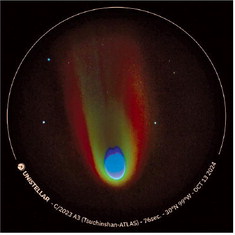As I write this on Oct. 21, we’ve had quite a nice week or so of fall temperatures. For that matter, even though it’s been unusually hot, we’ve had a really good run of clear skies for most of September and October.
We’ve also had a good look in mid-October of Comet Tsuchinshan-ATLAS which has been the brightest comet to grace our skies in 27 years. The last bright comet, Hale-Bopp could easily be seen in bright daylight, truly a once in a lifetime event for most people.
I used to go for a walk every evening after work in Austin and you could look up and see it and its tail naked eye two hours before dark.
I caught this comet on the first day it was visible, very low in the western sky. The reason it looks as it does is the sky was bright enough that my telescope’s computer chip picked up daytime colors per Unistellar, the telescope’s manufacturer.
As it rose higher in the sky a day later it looked more normal. Still, it’s an unusual photograph. The colors are real but exaggerated. It looks like the head of a match which is a pretty good description.
Some things to look for in November: — The Leonid meteor shower will peak in the morning hours of Nov 17. It is normally one of the better annual showers; however, this year a bright full moon will wash out most meteors. I’ll give it a pass this time.
— We will have two New Moons this month, on Nov. 1 and 30. That second is said to be a blue moon, so called because it’s the second new moon in a month. This really isn’t too unusual.
Next, I would like to share with you the open cluster and nebula called M16 in Sagittarius. In the center you can clearly see an active star-forming region popularly called the Pillars of Creation. Now this is no Hubble photograph but it’s good for a small backyard telescope at 44 minutes of exposure. Actually it’s 660 individual 4 second images, stacked and aligned. That’s how images such as this are made. The newspaper printing process doesn’t do justice to the actual results.
This was taken on Aug. 30, 2024. It’s approximately 5,700 light years distant toward the center of our Milky Way galaxy. It’s very easily visible in small telescopes in the later summer skies to the south.
It was first recorded in 1745. Yes, we’ve been doing astronomy for a very long time.
Now I would like to announce a hiatus in my scribbling. This is my 38th consecutive monthly column for the Boerne Star. I’m sure I’ll submit future articles as needed or wanted by the editor. It’s been a trip.
NIGHT SKIES








Comment
Comments